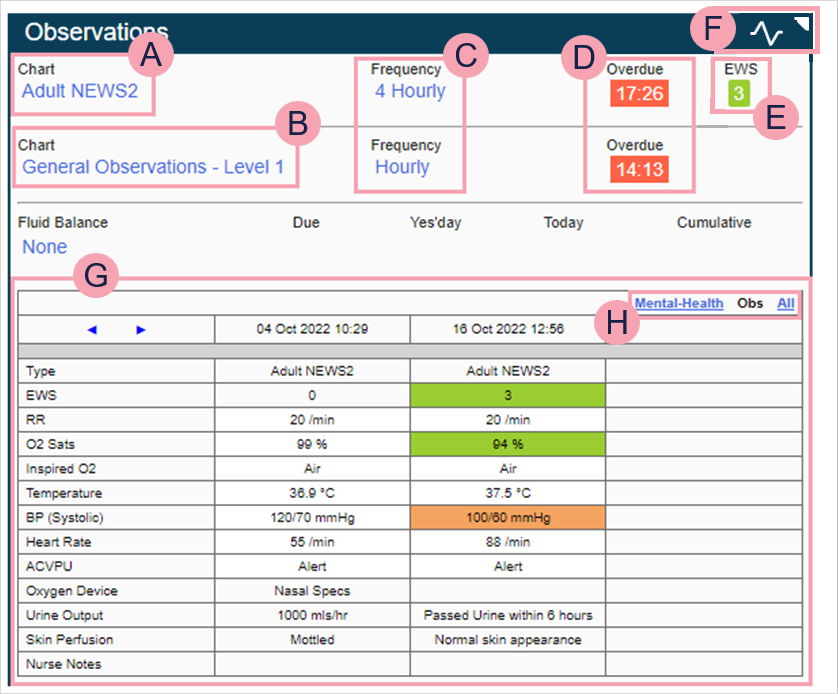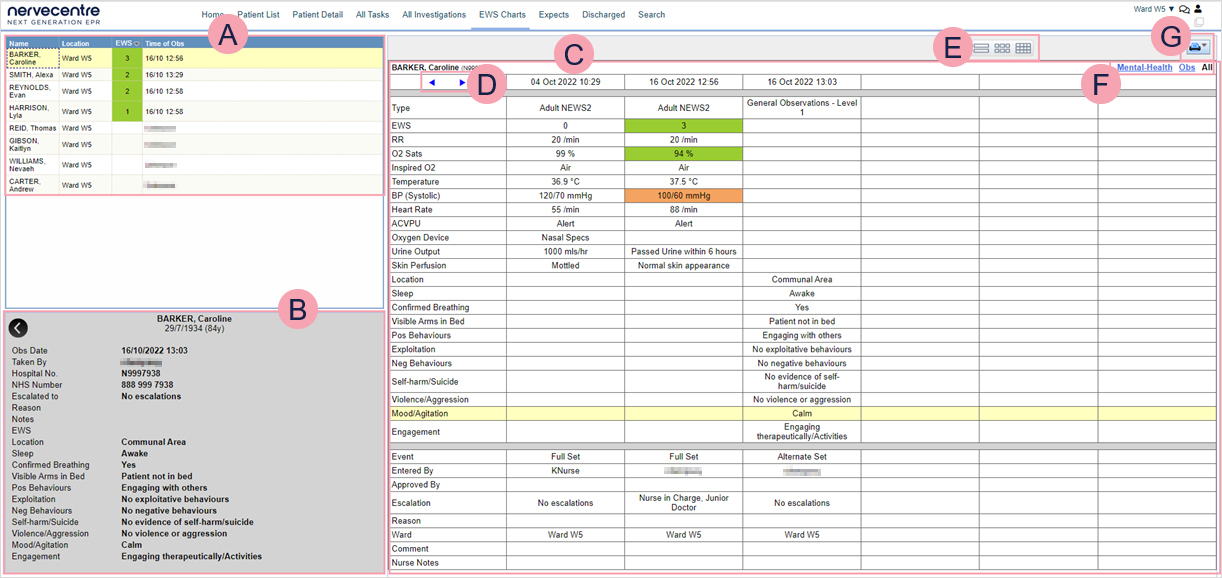Nervecentre V9.0 Help for Users
About observations
On a mobile, you can record a set of patient observations, view observations charts, and inform other clinicians of potential patient deterioration with escalations.
On a desktop, you can view observations in a table or on a graph, and enter observations if they appear in a form.
Nervecentre can automatically set an observation model depending upon location, age, or gender. This ensures that you have the right observation models available for your patient.
About observations on a mobile
 About observations
About observations
On a mobile, you can:
-
Record and submit a set of observations
-
Escalate to a colleague by sending a task to their mobile device
-
Change the frequency of observations
-
View observation charts in a table or on a graph, including Early Warning Scores (EWS) Early Warning Score. A vital signs recording and scoring system used with adult patients. The scoring system is designed to identify and alert appropriate staff in the case of deteriorating patients.
-
Add a specific observation model depending upon a patients’ needs
-
Add an unscheduled observation, which does not affect the observation schedule
-
Strike out observations when an error has been made
-
View a summary of EWS
-
View indicators that show when observations are due and overdue
 Finding observations
Finding observations
-
From your patient list, select a patient, or scan a patient's wristband.
-
From Obs & Assessments, select Obs.
 Overview of observations
Overview of observations

|
|
The base observation model.
Read more about recording observations |
|
|
Select to record an unscheduled observation. For example, you might record bowel movements or temperature. Observations recorded here do not alter the frequency. |
|
|
Select to choose a governed chart. A governed chart is an addition observation chart to be used together with the base observation model, for example, height and weight, or mental health observations. These charts can have their own escalations outside of the base model. |
|
|
Select to choose a different observation model. Observation models from here become the base observation model. These can contain unique observation parameters, advisory messages, escalations, and mandatory options. |
|
|
The history of observations is shown here. The history includes when a circumstance changes, for example, the patient transfers to a new location, or is allocated a different observation model. You can strike out observations from the history if you have made an error. |
|
|
Select to view observation charts. |
About observations on a desktop
 About observations
About observations
On a desktop you can:
-
Record a set of observations if they’re included in a form
For example, as part of the triage form in ED.
-
Escalate to a colleague by sending a task to their mobile device
-
View observation charts in a table or on a graph, including Early Warning Scores (EWS) Early Warning Score. A vital signs recording and scoring system used with adult patients. The scoring system is designed to identify and alert appropriate staff in the case of deteriorating patients.
-
View the times observations become overdue
-
See details of all observations for patients on a patient list
 Finding observations from Inpatients
Finding observations from Inpatients
From a desktop, you can view an individual set of patient observations, or an overall summary of the EWS Early Warning Score. A vital signs recording and scoring system used with adult patients. The scoring system is designed to identify and alert appropriate staff in the case of deteriorating patients. for all patients on your list.
To view a summary of a patient’s observations:
-
From Inpatients > Patient List > double-click on a patient's name > Patient Detail, select Clinical.
-
Find Observations.
To view observations for all patients on your patient list:
-
From Inpatients, select EWS Charts.
 Overview of observations for a patient
Overview of observations for a patient
From Patient Detail > Clinical > Observations, you can view observations for a patient.

|
|
The name of the base observation model. |
|
|
The names of any governed charts. |
|
|
The frequency associated with the observation model. |
|
|
The time an observation became overdue. |
|
|
The most recent Early Warning Score associated with the model. Not all observation models calculate an EWS Early Warning Score. A vital signs recording and scoring system used with adult patients. The scoring system is designed to identify and alert appropriate staff in the case of deteriorating patients.. |
|
|
Select Select ◥ to expand the chart across the width of the page. |
|
|
The observation chart. Coloured sections relate to the EWS associated with the value entered. Select or to navigate backward or forward through submitted observations. |
|
|
Select to show specific observations, for example mental health, or select All to see all observations entered in one chart. |
 Overview of observations for all patients
Overview of observations for all patients
From Inpatients > EWS Charts you can view observation details for all patients on your patient list.

|
|
Your patient list. Select a name to open the chart. Select EWS to order the list by EWS Early Warning Score. A vital signs recording and scoring system used with adult patients. The scoring system is designed to identify and alert appropriate staff in the case of deteriorating patients. increasing or decreasing. |
|
|
Details of the observations recorded, including:
|
|
|
The observation chart. |
|
|
Select the arrows to view observations over a different time period. |
|
|
Select to show different views of the observation charts:
|
|
|
Select to show specific observations in isolation, for example, mental health, or All to see all observations entered in one chart. |
|
|
Select to print observations. You can print in either colour or black and white (B&W). You print the view that you have open on the desktop. |
Did you find this article helpful? Yes No
Sorry about that. Our help is a work in progress and we welcome any feedback.
Why wasn't this helpful? Please select one reason:
Great!
Thanks for taking the time to give us some feedback.








 to show the chart in a grid view. The grid view is the default view.
to show the chart in a grid view. The grid view is the default view.